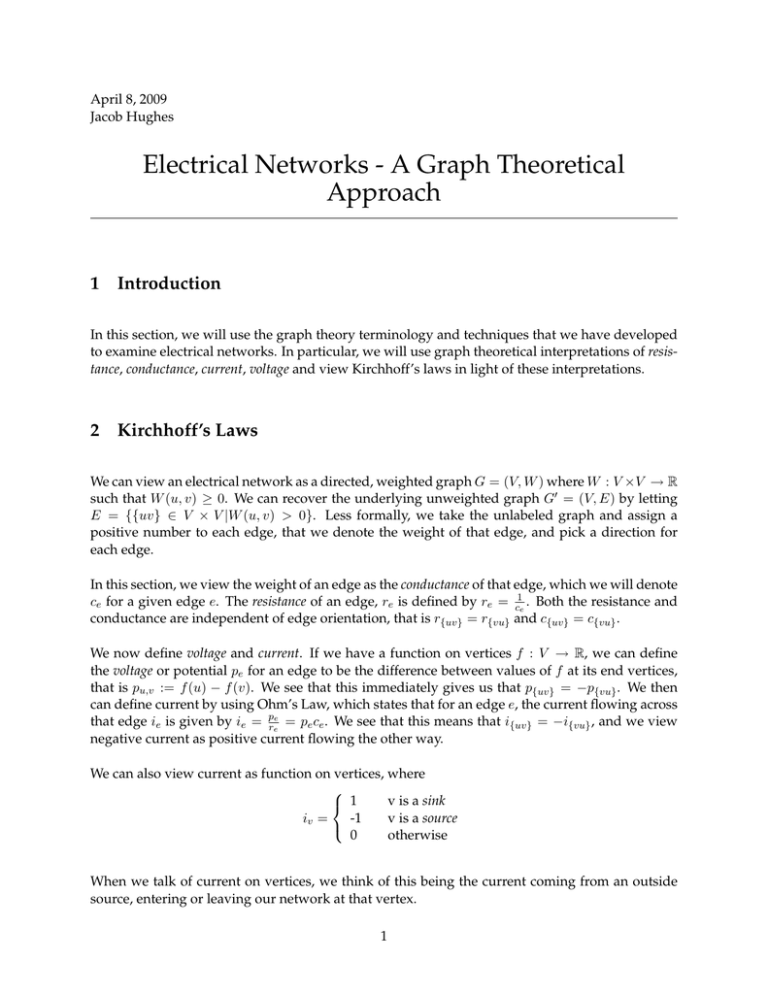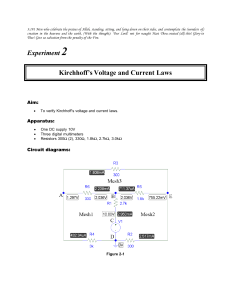Electrical Networks - A Graph Theoretical Approach
advertisement

April 8, 2009
Jacob Hughes
Electrical Networks - A Graph Theoretical
Approach
1
Introduction
In this section, we will use the graph theory terminology and techniques that we have developed
to examine electrical networks. In particular, we will use graph theoretical interpretations of resistance, conductance, current, voltage and view Kirchhoff’s laws in light of these interpretations.
2
Kirchhoff’s Laws
We can view an electrical network as a directed, weighted graph G = (V, W ) where W : V ×V → R
such that W (u, v) ≥ 0. We can recover the underlying unweighted graph G0 = (V, E) by letting
E = {{uv} ∈ V × V |W (u, v) > 0}. Less formally, we take the unlabeled graph and assign a
positive number to each edge, that we denote the weight of that edge, and pick a direction for
each edge.
In this section, we view the weight of an edge as the conductance of that edge, which we will denote
ce for a given edge e. The resistance of an edge, re is defined by re = c1e . Both the resistance and
conductance are independent of edge orientation, that is r{uv} = r{vu} and c{uv} = c{vu} .
We now define voltage and current. If we have a function on vertices f : V → R, we can define
the voltage or potential pe for an edge to be the difference between values of f at its end vertices,
that is pu,v := f (u) − f (v). We see that this immediately gives us that p{uv} = −p{vu} . We then
can define current by using Ohm’s Law, which states that for an edge e, the current flowing across
that edge ie is given by ie = pree = pe ce . We see that this means that i{uv} = −i{vu} , and we view
negative current as positive current flowing the other way.
We can also view current as function on vertices, where
v is a sink
1
-1
v is a source
iv =
0
otherwise
When we talk of current on vertices, we think of this being the current coming from an outside
source, entering or leaving our network at that vertex.
1
In general, the values for the source and the sink need not be 1, but we will restrict ourselves
to that case. We think of this as 1 unit of current entering the network at the source, and 1 unit
leaving at the sink. So far, all of our definitions and rules have been for a single edge, or pair
of vertices connected by an edge. A natural question then arises, how does the structure of the
network determine current and voltage? This is partially answered by Kirchhoff’s Laws.
Kirchhoff’s Current Law
iV = iE B ∗ .
Here, iV is the vector giving values iv for each v ∈ V , iE is the vector giving values ie for each
e ∈ E, and B is the directed edge adjacency matrix, the |V | × |E| matrix where
v is the head of e
1
-1
v is the tail of e
Bv,e =
0
otherwise
Kirchhoff’s Current Law can also be stated as
iv =
X
i{uv} ,
u∼v
and can be thought of as ”what goes in must come out.”
Kirchoff’s Voltage Law
For any cycle v1 , v2 , · · · , vk ,
k+1
X
p{vj vj+1 } = 0,
j=1
where vk+1 = v1 .
A special case of Kirchhoff’s Voltage law occurs when all edges have the same resistance, which
then tells us (by Ohm’s Law) that
k+1
X
i{vj vj+1 } = 0,
j=1
Connection with the Combinatorial Laplacian
We can now see how our combinatorial Laplacian relates to electrical networks. By Ohm’s Law,
for given edge e we have that ie = pe ce , and we know that p{uv} := f (u) − f (v), so we can express
the vector iE = fV BC, where C is the |E| × |E| diagonal matrix of giving the conductances
on each edge. But then we can use this conjunction with Kirchhoff’s Current Law to state that
iV = iE B ∗ = fV BCB ∗ = fV L, where L is the weighted combinatorial Laplacian.
2
3
A Simple Case
We now restrict ourselves to a specific case, where G is a wieghted graph with no loops, no multiple edges between vertices, and each edge has weight 1.
Theorem 1. Given such a G, and s, tinV (G), the source and sink, respectively, we can claim that the
following current distribution satisfies Kirchhoff’s laws:
I{uv} =
τ (s, a, b, t) − τ (s, b, a, t)
,
τ (G)
where τ (G) is the number of spanning trees of G, and τ (s, a, b, t) is the number of spanning trees of G such
that the path running from s to t goes through a and then b.
Proof. For a given spanning tree T , we define
T contains a path from s to t that runs through a and then b
1
(T )
-1
T contains a path from s to t that runs through b and then a
i{ab} =
0
otherwise
(T )
We notice that for any T , the current distribution given by i{ab} satisfies the Kirchhoff Current
Law. Also, we notice that if any two distributions satisfy the Current Law, then their sum does
P (T )
as well. Therefore the sum T i{ab} also satisfies the Current Law, and we see it has total charge
P (T )
τ (G). Let i{ab} = T i{ab} = τ (s, a, b, t) − τ (s, b, a, t). We know that the distribution i{ab} satisfies
the current law, so it remains to show that is satisfies the voltage law as well. Since we assumed
the resistance was 1 for each edge, we can deal with the special case.
In other words, we must show that for a cycle v1 , v2 , · · · , vk ,
k+1
X
i{vj vj+1 } = 0,
j=1
which is to show that
k+1 X
X
(T )
i{vj vj+1 } = 0.
j=1 T
To do this, we first define a thicket. A thicket is a spanning forest with exactly two components,
one containing s and one containing t. For a thicket F , we define
(
(F ∪{ab})
i{ab}
if F ∪ {ab} is a spanning tree
=
0
otherwise
P (T )
P (F )
P
(F )
Then we notice that T i{ab} = F i{ab} , and that for a fixed thicket F we have k+1
j=1 i{vj vj+1 } = 0.
They sum to zero since any cycle will in G will have an even number of “crossings” between the
(F )
i{ab}
3
two components of F, with half of which will get weighted with a 1, and the other half will be
weighted with a −1.
Then we put all these together and conclude that
k+1 X
X
j=1 T
(T )
i{vj vj+1 } =
k+1 X
X
(F )
i{vj vj+1 } =
j=1 F
k+1
XX
F
(F )
i{vj vj+1 } =
j=1
X
0 = 0.
F
Therefore the current distribution i{uv} = τ (s, a, b, t) − τ (s, b, a, t) satisfies both the current laws,
and has current τ (G) flowing from s to t. Letting I{uv} =
i{uv}
τ (G)
gives our result.
References
[1] B. Bollobás, Modern Graph Theory, Springer 1998.
[2] F. Kirchhoff, Über die Auflösung der Gleichungen, auf welche man bei der Untersuchung der
linearen Verteilung galvanischer Ströme geführt wird, Ann. Phys. chem. 72 (1847), 497–508
4



